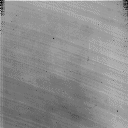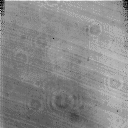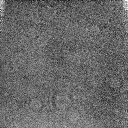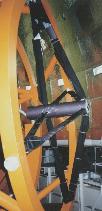 Daytime Sky 40 degrees from the Sun
Daytime Sky 40 degrees from the SunThe sun is on most of the secondary spider, and most of the secondary mirror housing, but not on the lowermost part of the housing or the secondary mirror itself.
Observers at the NASA Infrared Telescope Facility (IRTF), on Mauna Kea, Hawaii, sometimes need to take daytime images at small solar elongations (time-critical monitoring of Jupiter or Io, or comets, for instance). When looking sufficiently close to the sun, (less than about 35 degrees), NSFCAM image quality and photometric accuracy are severely compromised by the appearance of donut-like diffraction patterns on the chip, which do not subtract out in object/sky pairs. This page documents the appearance of these "donuts" and describes our attempts to eliminate them.
 Daytime Sky 40 degrees from the Sun
Daytime Sky 40 degrees from the Sun
The sun
is on most of the secondary spider, and most of the secondary mirror
housing, but not on the lowermost part of the housing or the secondary
mirror itself.
 Daytime Sky 30 degrees from the Sun
Daytime Sky 30 degrees from the Sun
Note the "donuts" that aren't seen further from the sun. The sun is now on
the whole secondary mirror housing, including the secondary mirror itself.
 Object-Sky frame, 30 degrees from the Sun
Object-Sky frame, 30 degrees from the Sun
Beamswitch 60 N. Note that the "donuts" don't subtract out very well, making
accurate photometry difficult. The donuts are, however, fairly reproducible
at a given pointing position and don't appear in the difference
between two consecutive object frames taken without beamswitching between them.
Varying the beamswitch direction seems to help with subtraction (see
"The Solution?")
The fact that the donuts appear when the secondary mirror is illuminated
sounds like an important clue, but wrapping the lower secondary mirror
housing in black paper, including the circumference of the mirror itself,
does not eliminate the donuts.
We also tried getting object/sky pairs by moving the chopping secondary instead of the whole telescope, but this did not help significantly.
 Attempt to remove the "donuts"
Attempt to remove the "donuts"
On 96/11/08
we used black paper and black cloth to cover up the silvered surfaces
of the secondary spider and the secondary mirror housing, in case
reflection off these surfaces was the cause of the "donuts". We
weren't able to get test images that day, but on 96/11/29 John
Stansberry repeated the experiment and found that it gave at most a
modest improvement in scattered light. The recent silvering of the
IRTF secondary support structure thus does not seem to be the source
of the problem.